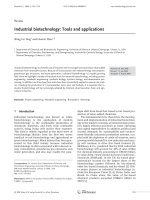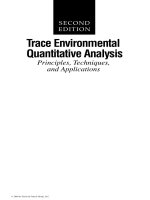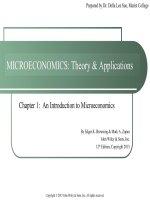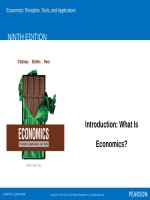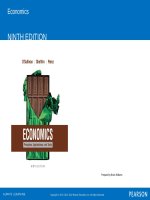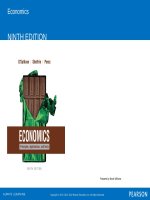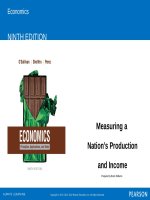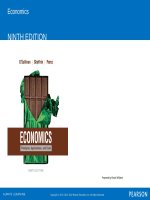Economics principles tools and applications 9th by sullivan sheffrin perez chapter 01
Bạn đang xem bản rút gọn của tài liệu. Xem và tải ngay bản đầy đủ của tài liệu tại đây (3.66 MB, 34 trang )
Economics: Principles, Tools, and Applications
NINTH EDITION
Chapter 1
Introduction: What Is
Economics?
Economics is the science of choice, exploring the
choices made by individuals and organizations.
Copyright © 2017, 2015, 2012 Pearson Education, Inc. All Rights Reserved
Learning Objectives
1.1 List the three key economic questions
1.2 Discuss the insights from economics for a real-world
problem such as congestion
1.3 List the four elements of the economic way of thinking
1.4 List three ways to use macroeconomics
1.5 List three ways to use microeconomics
Copyright © 2017, 2015, 2012 Pearson Education, Inc. All Rights Reserved
1.1 WHAT IS ECONOMICS? (1 of 5)
•
Scarcity
The resources we use to produce goods and services are limited.
•
Economics
The study of choices when there is scarcity.
Here are some examples of scarcity and the trade-offs associated with making choices:
•
You have a limited amount of time. Each hour on the job means one less hour for study or play.
•
A city has a limited amount of land. If the city uses an acre of land for a park, it has one less acre for
•
You have limited income this year. If you spend $17 on a music CD, that’s $17 less you have to spend on other products or to save.
Copyright © 2017, 2015, 2012 Pearson Education, Inc. All Rights Reserved
housing, retailers, or industry.
1.1 WHAT IS ECONOMICS? (2 of 5)
Factors of Production
The resources used to produce goods and services; also known as production inputs, or resources.
•
Natural Resources
Resources provided by nature and used to produce goods and services.
•
Labor
Human effort, including both physical and mental effort people, used to produce goods and services.
•
Physical Capital
The stock of equipment, machines, structures, and infrastructure that is used to produce goods and services.
•
Human Capital
The knowledge and skills acquired by a worker through education and experience and used to
•
produce goods and services.
Entrepreneurship
The effort used to coordinate the factors of production—natural resources, labor, physical capital, and human capital—to produce and sell products.
Copyright © 2017, 2015, 2012 Pearson Education, Inc. All Rights Reserved
1.1 WHAT IS ECONOMICS? (3 of 5)
Positive versus Normative Analysis
•
● Positive
Analysis
Answers the question “What is?” or “What will be?”
•
●
Normative Analysis
Answers the question “What ought to be?”
Copyright © 2017, 2015, 2012 Pearson Education, Inc. All Rights Reserved
1.1 WHAT IS ECONOMICS? (4 of 5)
The Three Key Economic Questions: What, How, and Who?
.
The choices made by individuals, firms, and governments answer three questions:
1.
What products do we produce?
2.
How do we produce the products?
3.
Who consumes the products?
Copyright © 2017, 2015, 2012 Pearson Education, Inc. All Rights Reserved
1.1 WHAT IS ECONOMICS? (5 of 5)
Economic Models
● Economic
model
A simplified representation of an economic environment, often employing a graph.
Copyright © 2017, 2015, 2012 Pearson Education, Inc. All Rights Reserved
1.2 ECONOMIC ANALYSIS AND
MODERN PROBLEMS (1 of 4)
Economic View of Traffic Congestion
To an economist, the diagnosis of the problem is straightforward.
•
•
•
•
•
•
Your car takes up space and decreases the distance between the vehicles on the highway.
The normal reaction to a shorter distance between moving cars is to slow down.
So when you enter the highway, you force other commuters to spend more time on the highway.
One possible solution to the problem is to force people to pay for using the road, just as they pay for gasoline and tires.
The job for the economist is to compute the appropriate congestion tax and predict the consequences of imposing the tax.
Copyright © 2017, 2015, 2012 Pearson Education, Inc. All Rights Reserved
1.2 ECONOMIC ANALYSIS AND
MODERN PROBLEMS (2 of 4)
Economic View of Poverty in Africa
Africa is the world’s second-largest continent in both area and population, and accounts for more than 12 percent of the world’s human population.
The countries of sub-Saharan Africa are highlighted in green in Figure 1.1 (see next slide).
Copyright © 2017, 2015, 2012 Pearson Education, Inc. All Rights Reserved
1.2 ECONOMIC ANALYSIS AND
MODERN PROBLEMS (3 of 4)
Copyright © 2017, 2015, 2012 Pearson Education, Inc. All Rights Reserved
1.2 ECONOMIC ANALYSIS AND
MODERN PROBLEMS (4 of 4)
Economic View of the Current World Recession
•
Over the last several decades, the U.S. economy has performed well and has raised our standard of living. Although the economy faltered at times, policymakers
seemed to know how to restore growth and prosperity.
That is why the financial crisis and the recession that began in late 2007 have so shaken the confidence of people in the United States and around the world.
•
The problems started innocently enough, with a booming market for homes that was fueled by easy credit from financial institutions.
•
But we later discovered that many purchasers of homes and properties could not really afford them, and the trouble spread to banks and other financial institutions.
•
As a result, businesses found it increasingly difficult to borrow money for everyday use and investment, and economic activity around the world began to contract.
The major countries of the world have implemented aggressive policies to try to halt this downturn.
Copyright © 2017, 2015, 2012 Pearson Education, Inc. All Rights Reserved
1.3 THE ECONOMIC WAY OF
THINKING (1 of 2)
Use Assumptions to Simplify
Economists use assumptions to make things simpler and focus attention on what really matters.
Isolate Variables—Ceteris Paribus
Economic analysis often involves variables and how they affect one another.
•
Variable
A measure of something that can take on different values.
•
Ceteris Paribus
A Latin expression meaning that other variables are held fixed.
Copyright © 2017, 2015, 2012 Pearson Education, Inc. All Rights Reserved
1.3 THE ECONOMIC WAY OF
THINKING (2 of 2)
Think at the Margin
How will a small change in one variable affect another variable and what impact that has on people’s decision making.
•
Marginal change
A small, one-unit change in value
Rational People Respond to Incentives
A key assumption of most economic analysis is that people act rationally, meaning that they act in their own self-interest.
Copyright © 2017, 2015, 2012 Pearson Education, Inc. All Rights Reserved
APPLICATION 1
INCENTIVES TO BUY HYBRID VEHICLES
•
APPLYING THE CONCEPTS #1: How do people respond to incentives?
Consider the incentive to buy a hybrid vehicle, which is more fuel efficient but more expensive than a gas-powered vehicle.
Between 2000 and 2007 the number of hybrid vehicles increased from fewer than 10,000 to more than 340,000 vehicles and over the same period the price of gasoline increased
significantly.
•
The higher price of gasoline was responsible for roughly one third of hybrid vehicles purchased in 2007
•
In addition, a federal subsidy of up to $3,400 was responsible for roughly one fifth of the hybrid vehicles purchased in 2007.
The increase in the number of hybrid vehicles decreased the emission of the greenhouse gas CO2.
How efficient is the hybrid subsidy in reducing CO2? The cost of abating one ton of CO2 through the subsidy is $177. There are less costly ways of reducing CO2 emissions.
Copyright © 2017, 2015, 2012 Pearson Education, Inc. All Rights Reserved
Example: London Addresses Its Congestion Problem
To illustrate the economic way of thinking, let’s consider again how an economist would
approach the problem of traffic congestion.
Each driver on the highway slows down other drivers but ignores these time costs when
deciding whether to use the highway.
If the government imposes a congestion tax to reduce traffic during rush hour, the economist is faced with a question: How high should the tax be?
•
Use assumptions to simplify. We assume every car has the same effect on the travel time of other cars.
•
Isolate variables—ceteris paribus. We would make the ceteris paribus assumption that everything else that affects travel behavior—the price of gasoline, bus fares, and consumer
income—remains fixed.
•
Think at the margin. We would estimate the effects of adding one more car to the highway.
If the marginal driver forces each of the 900 commuters to spend two extra seconds on the highway, total travel time increases by 30 minutes.
If the value of time is, say, $16 per hour, the appropriate congestion tax would be $8 (equal to 16 x ½ hour).
Copyright © 2017, 2015, 2012 Pearson Education, Inc. All Rights Reserved
APPLICATION 2
HOUSING PRICES IN CUBA
APPLYING THE CONCEPTS #2: What is the role of prices in allocating resources?
In 1960 the government confiscated most housing and outlawed its sale and rental.
Tenants who paid monthly rent to the government for 20 years officially owned the dwelling, but could not sell or rent it to others.
With no possible sale or rent, the homeowners had less incentive to repair and maintain their property. As a result, a large percentage of the stock of housing is in poor
condition and few new dwellings have been built in the last 50 years.
Housing reforms n 2011 restored prices to the Cuban housing market and authorizes the sale and purchase of homes.
Economists expect homeowners to have more incentive to repair and maintain their dwellings and for builders to increase construction.
Copyright © 2017, 2015, 2012 Pearson Education, Inc. All Rights Reserved
1.4 PREVIEW OF COMING ATTRACTIONS:
MACROECONOMICS
(1 of 2)
Macroeconomics
The study of the nation’s economy as a whole; focuses on the issues of inflation, unemployment, and economic growth.
Macroeconomics explains why economies grow and change and why economic growth is sometimes interrupted.
Using Macroeconomics to Understand Why Economies Grow
Macroeconomics explains why resources increase over time and the consequences for our standard of living.
Copyright © 2017, 2015, 2012 Pearson Education, Inc. All Rights Reserved
1.4 PREVIEW OF COMING ATTRACTIONS:
MACROECONOMICS
(2 of 2)
Using Macroeconomics to Understand Economic Fluctuations
All economies, including ones that experience a general trend of rising per capita income, are subject to economic
fluctuations, including periods when the economy shrinks.
Using Macroeconomics to Make Informed Business Decisions
A manager who studies macroeconomics will be better equipped to understand the complexities of interest rates and inflation
and how they affect the firm.
Copyright © 2017, 2015, 2012 Pearson Education, Inc. All Rights Reserved
1.5 PREVIEW OF COMING ATTRACTIONS: MICROECONOMICS (1 of 2)
Microeconomics
The study of the choices made by households, firms, and government and how these choices affect the markets for goods
and services.
Using Microeconomics to Understand Markets and Predict Changes
One reason for studying microeconomics is to better understand how markets work and to predict how various events affect
the prices and quantities of products in markets.
Copyright © 2017, 2015, 2012 Pearson Education, Inc. All Rights Reserved
1.5 PREVIEW OF COMING ATTRACTIONS: MICROECONOMICS (2 of 2)
Using Microeconomics to Make Personal and Managerial Decisions
On the personal level, we use economic analysis to decide how to spend our time, what career to pursue, and how to spend
and save the money we earn. Managers use economic analysis to decide how to produce goods and services, how much to
produce, and how much to charge for them.
Using Microeconomics to Evaluate Public Policies
We can use economic analysis to determine how well the government performs its roles in the market economy.
Copyright © 2017, 2015, 2012 Pearson Education, Inc. All Rights Reserved
KEY TERMS
Ceteris paribus
Marginal change
•
Economic model
Microeconomics
•
Economics
Natural resources
•
Entrepreneurship
Normative analysis
Factors of production
Physical capital
Human capital
Positive analysis
•
Labor
Scarcity
•
Macroeconomics
Variable
Copyright © 2017, 2015, 2012 Pearson Education, Inc. All Rights Reserved
CHAPTER 1 APPENDIX
▼FIGURE 1A.1
Graphs Single Variables
Copyright © 2017, 2015, 2012 Pearson Education, Inc. All Rights Reserved
▼FIGURE 1A.2
Times-Series Graph
Copyright © 2017, 2015, 2012 Pearson Education, Inc. All Rights Reserved
APPENDIX A USING GRAPHS AND PERCENTAGES
1A.1 USING GRAPHS (1 of 8)
One variable is measured along the horizontal, or x, axis, while the
other variable is measured along the vertical, or y, axis.
The origin is defined as the intersection of the two axes, where the
values of both variables are zero.
The dashed lines show the values of the two variables at a
particular point.
Copyright © 2017, 2015, 2012 Pearson Education, Inc. All Rights Reserved
APPENDIX A USING GRAPHS AND PERCENTAGES
1A.1 USING GRAPHS (2 of 8)
There is a positive relationship between work hours and
income, so the income curve is positively sloped.
The slope of the curve is $8: Each additional hour of work
increases income by $8.
Copyright © 2017, 2015, 2012 Pearson Education, Inc. All Rights Reserved
